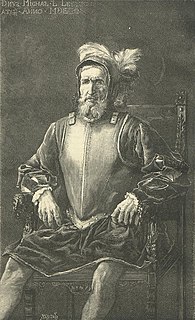 W
WThis is a list of conquistadors who were active in the conquest of terrains that presently belong to Colombia. The nationalities listed refer to the state the conquistador was born into; Granada and Castile are currently part of Spain, but were separate states at the time of birth of the early conquistadors. Important conquistadors and explorers were Alonso de Ojeda, who landed first at Colombian soil and founded the first settlement Santa Cruz, Rodrigo de Bastidas, who founded the oldest still remaining city Santa Marta, Pedro de Heredia, who founded the important city of Cartagena in 1533, Gonzalo Jiménez de Quesada, who was the leader of the first and main expedition into the Andes (1536–1538), with his brother second in command and many other conquistadors, 80% of whom who didn't survive, and Nikolaus Federmann and Sebastián de Belalcázar who entered the Colombian interior from the northwest and south respectively.
 W
WJuan de Garay (1528–1583) was a Spanish conquistador. Garay's birthplace is disputed. Some say it was in the Castile city of Junta de Villalba de Losa, while others argue he was born in the area of Orduña. There's no birth certification whatsoever, though Juan De Garay regarded himself as somebody from Biscay. He served under the Crown of Castille, in the Viceroyalty of Peru. He was governor of Asunción and founded a number of cities in present-day Argentina, many near the Paraná River area, including the second foundation of Buenos Aires, in 1580.
 W
WMiguel López de Legazpi, also known as El Adelantado and El Viejo, was a Spanish navigator and governor who established the first Spanish settlement in the East Indies when his expedition crossed the Pacific Ocean from the Viceroyalty of New Spain in modern-day Mexico, arriving in Cebu in the Philippine Islands in 1565. He was the first Governor-General of the Spanish East Indies, which was governed and mainly located in the Philippines. It also encompassed other Pacific islands namely Guam and the Mariana Islands. After obtaining peace with various indigenous nations and kingdoms, he made Cebu City the capital of the Spanish East Indies in 1565 and later transferred to Manila in 1571. The capital city of the province of Albay bears his name.
 W
WDomingo Martínez de Irala was a Spanish Basque conquistador.
 W
WJuan de Oñate y Salazar was a Spanish conquistador from New Spain, explorer, and colonial governor of the province of Santa Fe de Nuevo México in the viceroyalty of New Spain. He led early Spanish expeditions to the Great Plains and Lower Colorado River Valley, encountering numerous indigenous tribes in their homelands there. Oñate founded settlements in the province, now in the Southwestern United States.
 W
WMartín Ruiz de Gamboa de Berriz was a Spanish Basque conquistador who served as a Royal Governor of Chile.
 W
WJuan de Salcedo was a Spanish conquistador. He was born in Mexico in 1549 and he was the grandson of Miguel López de Legazpi and brother of Felipe de Salcedo. Salcedo was one of the soldiers who accompanied the Spanish colonization of the Philippines in 1565. He joined the Spanish military in 1564 for their exploration of the East Indies and the Pacific, at the age of 15. In 1567, Salcedo led an army of about 300 Spanish and Mexican soldiers and 600 Visayan (Filipino) allies along with Martín de Goiti for their conquest of Islamic Manila. There they fought a number of battles against the Muslim leaders, mainly against Tarik Sulayman. The Spanish officers, Mexican recruits and Filipino warriors coalesced in 1570 and 1571 to attack the Islamised areas of Luzon, for control of lands and settlements.
 W
WPedro de Ursúa was a Spanish conquistador from Baztan in Navarre. In Panama, Ursúa subdued a Cimarron (ex-slave) revolt by tricking Cimarron leader Bayano into coming unprepared to negotiate a truce, but then captured him and sent him back to King Philip II of Spain.